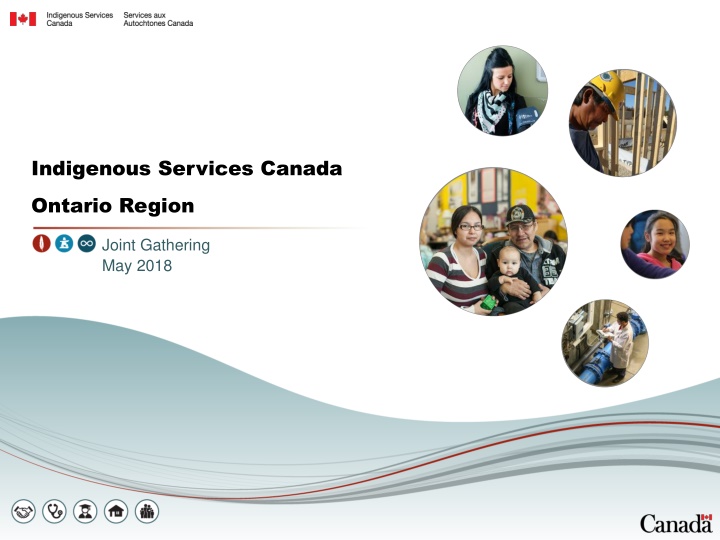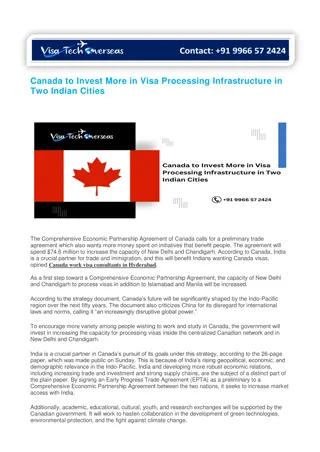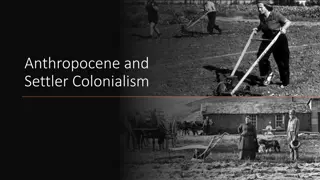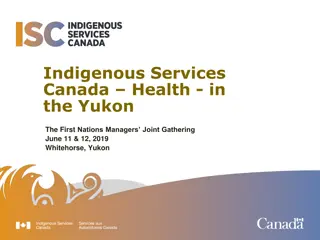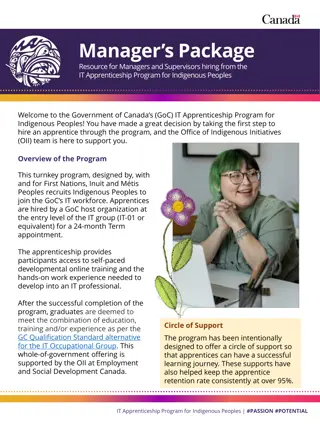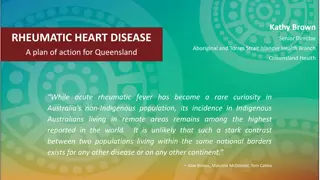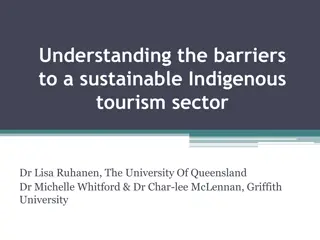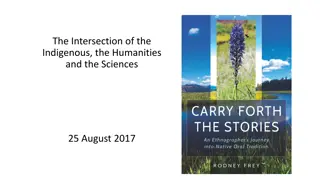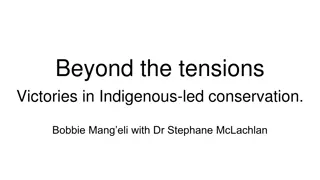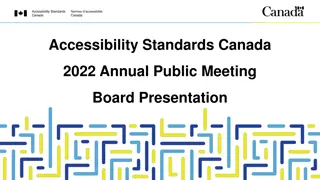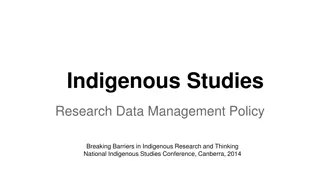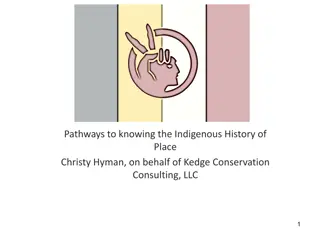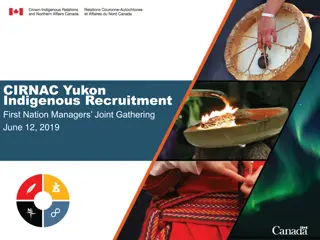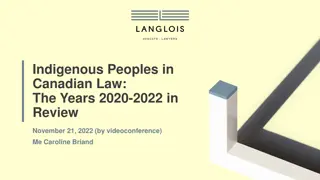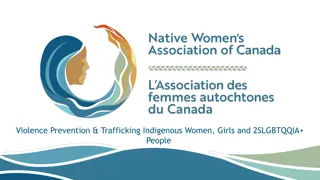Indigenous Services Canada Achievements and Initiatives Overview
Indigenous Services Canada in Ontario region held a joint gathering in May 2018, leading to the formation of a new department focusing on improving health outcomes for Indigenous communities. The department has made significant strides in enhancing services such as healthy child development, mental wellness initiatives, primary care, and implementing Jordans Principle. These efforts showcase a commitment to providing culturally appropriate and effective healthcare services to Indigenous peoples.
Uploaded on Oct 04, 2024 | 1 Views
Download Presentation

Please find below an Image/Link to download the presentation.
The content on the website is provided AS IS for your information and personal use only. It may not be sold, licensed, or shared on other websites without obtaining consent from the author.If you encounter any issues during the download, it is possible that the publisher has removed the file from their server.
You are allowed to download the files provided on this website for personal or commercial use, subject to the condition that they are used lawfully. All files are the property of their respective owners.
The content on the website is provided AS IS for your information and personal use only. It may not be sold, licensed, or shared on other websites without obtaining consent from the author.
E N D
Presentation Transcript
Indigenous Services Canada Ontario Region Joint Gathering May 2018
Department of Indigenous Services Canada First Nations and Inuit Health Branch (FNIHB) was combined with several elements of the former Indigenous and Northern Affairs Canada to create the new Department of Indigenous Services Canada. FNIHB will continue the important work of improving health outcomes within Indigenous Services Canada. Transforming how the Department is structured, shares information and works with its partners and clients will allow us to build stronger and better ways of delivering services to Indigenous people. 2
Improved Health Outcomes 2017-18 Achievements Healthy Child Development Increased funding for Fetal Alcohol Spectrum Disorder; and Prenatal and Maternal and Child Health to provide training/capacity building of community members Children s Oral Health Initiative funding increased Mental Wellness Roll-out of 19 mental wellness teams in Ontario co-funded with the province Social Emergencies Relationship Agreement recently signed by all parties Non-Insured Health Benefits Increased investments for services of Traditional Healers, Cultural Practitioners and Elders for culturally appropriate mental health services Policy changes coverage for prenatal escorts 4
Primary Care Home and Community Care increased funding established a new funding base for all communities Modernization of primary care, such as, implementation of multi-disciplinary approaches and virtual clinical technologies Transfer of Deer Lake nursing services to Keewaytinook Okimakanak Public Health Additional TB funding for community awareness; development and sharing of educational and promotional tools Support for harm reduction activities, for example, the HIV/AIDS Leadership and Network Conference 5
Implementing Jordans Principle: Under Jordan s Principle, to date FNIHB has provided over one hundred million dollars in funding for products, services and supports for First Nations communities and individual requests The Choose Life Initiative creates a concrete simplified process for communities in Nishnawbe Aski Nation territory to apply for mental health supports for children and youth through Jordan s Principle funding Infrastructure Investments: Social Infrastructure Funds (SIF) is accelerating replacements and major renovations to improve how health care is delivered in 7 northern health facilities SIF is also equipping two northern hospitals (Sioux Lookout and Moose Factory) to address renovations 9 of 15 AHSOR facilities received SIF investments building 2 new centres and 7 completing major renovations, repairs and all purchasing new equipment 6
Looking Forward Health System Transformation This change is reflected in tripartite work in health that builds on devolution work already underway. Tripartite agreements towards health transformation have been formalized with Nishnawbe Aski Nation, Grand Council Treaty #3, Anishinabek Nation and Six Nations of the Grand River 7
Quality education 2017/18 Highlights $136.4 million in new investments for Ontario First Nations elementary and secondary student programming $2 million for the implementation of the Anishinabek Education System 16 school feasibility studies were advanced $12.94 million to support 35 education infrastructure projects in 25 First Nations Work with the Chiefs of Ontario First Nation Education Coordination Unit on education transformation. Work with Six Nations on a draft framework to meet the needs of their entire student body, no matter what type of school they currently attend. 8
Children and families together 2017/18 Highlights $14.3 million to support to Nishnawbe Aski Nation s student safety plan for First Nation students who leave their Northern Ontario communities to attend school. In January 2018, a national Emergency Meeting on Child Welfare was held with Indigenous leaders, Indigenous Services Canada and provincial governments. The Federal Government committed to a six point action plan to work with Indigenous partners to address number of Indigenous children in care. In April 2018, First Nations, Canada and Ontario committed to jointly reform the policy and funding approaches for First Nations Child and Family Services in Ontario $9.1 million has been distributed to Ontario First Nations for prevention services on-reserve The federal government covers the actual costs of First Nations Child and Family Services Agencies in Ontario. 9
Reliable Infrastructure 2017/18 Highlights $28.4 million for 54 road and bridge projects in 41 First Nations 131 new housing units completed in 24 First Nations and 240 in progress at 32 First Nations. 94 home renovations completed in 10 First Nations, and 632 in progress at 79 First Nations (through Budget 2016). First Nation fire prevention activities and emergency response planning Connecting Shoal Lake No. 40 First Nations to the Trans-Canada Highway $2.2 million to support connectivity via the design phase of the Matawa Broadband Development $12 million for 80 Solid Waste Management projects, including studies, landfills or transfer stations, construction projects, outreach programs, etc. $17 million for 20 contaminated sites projects, including 4 large clean-up projects $57.25 million for 39 energy projects in 23 communities 10
Northern Ontario Grid Connection Project $1.6 billion for Wataynikaneyap Power to connect 16 First Nations to the provincial power grid. Pikangikum First Nation will be connected first, by end of calendar year 2018. The 16 communities to be connected by this project are: Bearskin Lake First Nation Deer Lake First Nation Kasabonika Lake First Nation Keewaywin First Nation Kingfisher First Nation Kitchenuhmaykoosib Inninuwug First Nation Muskrat Dam Lake First Nation North Caribou Lake First Nation North Spirit Lake First Nation Pikangikum First Nation Poplar Hill First Nation Sachigo Lake First Nation Sandy Lake First Nation Wapekeka First Nation Wawakapewin First Nation Wunnumin First Nation 11
Water and wastewater infrastructure on reserve $53.8 million for 88 water and wastewater infrastructure projects in 62 Ontario First Nations Investments in new water treatment plants and upgrades eliminated 16 long-term- drinking water advisories in 6 Ontario First Nations serving approximately 2,200 people 12
New Fiscal Relationship 2017/18 Highlights Exploring new approaches to funding mechanisms and supporting economic development 6 additions to reserve were completed in 2017/18 $4 million for First Nation Land Management; 3 First Nations became operational under First Nation Land Management Act $3.9 million for 64 First Nations projects to support governance capacity $2.5 million to IROs for organizational capacity and $1.6 million for 15 proposal driven initiatives 13
Improved Health Outcomes Budget 2017 builds on previous budgets and commits an additional $61.9 million to allocate directly to First Nations in Ontario Budget 2018 commits an addition $1.4B nationally 14
ISC FNIHB Regional Budget Highlights Indian Residential Schools, $4,800,719 Communicable Disease Control & Management, $4,073,255 Clinical & Client Care, $15,866,298 2017/18 Contribution Funding Forecast Expenditures: $340,184,588* (Total 2016-2017 $268,328,889*) *does not include O&M including NIHB, IRS and Jordan s Principle Jordan Principle/CFI, $57,543,157 E-Health Infostructure, $5,455,432 Environmental Health, $2,129,517 Health Facilities, $49,474,134 Non-Insured & Health Benefits, $40,451,101 Health Planning & Quality Management, $24,361,450 Systems Integration, $4,873,275 Healthy Child Development, $23,911,616 Healthy Living, $14,647,700 Mental Wellness, $69,367,173 Home & Community Care, $23,229,761 15
Regional Operations Budget Highlights G+C Funds committed to First Nations in Ontario in 2017/18 $1,397,580,405 16
Regional Operations: cost to administer 17/18 funding *G+Cs total on this slide does not include gas tax fund 17
Engagement on the recognition of Indigenous rights The Government of Canada has committed to the review of its laws, policies and operational practices to ensure the constitutional commitments made to Indigenous peoples are respected. The engagement will focus on: accelerating progress toward self-determination, with a focus on nation and government rebuilding and rights recognition legislation to anchor Canada's relationship with First Nations, Inuit and M tis in rights recognition and develop tools for the recognition of Indigenous governments elements of a new policy, based on the distinct needs of First Nations, Inuit and M tis to replace the current Comprehensive Land Claims and Inherent Right to Self-Government policies creating two new departments that can better serve the distinct needs of First Nations, Inuit and M tis 18
National ongoing consultation and engagement activities On-reserve infrastructure reform: Engagement Reform of the Capital Facilities and Maintenance Program to better support First Nation self-determination, which includes sufficient and predictable funding Safe Drinking Water for First Nations Act: Engagement Collaborating with the Assembly of First Nations to address concerns regarding the Safe Drinking Water for First Nations Act and decide on a course of action to ensure safe drinking water for the residents of First Nations communities First Nation education transformation: Engagement Ongoing engagement to ensure that all First Nation students receive a culturally responsive high-quality education that improves student outcomes, while respecting regional priorities and First Nations control of First Nation education Housing strategies with First Nations, the Inuit and the M tis Nation Three distinctions-based housing strategies with First Nations, the Inuit and the M tis Nations to improve housing conditions ensure that Indigenous Peoples have greater control over housing in their communities 19
Completed national consultation and engagement activities Family Homes on Reserves and Matrimonial Interests or Rights Act Engagement 2017-2018 (ended 2018) Improving child and family services in First Nations communities Engagement 2016-2017 (ended 2017) Finding solutions: Reserve Lands and Environment Management Program Engagement 2017 (ended 2017) A new fiscal relationship Engagement 2017 (ended 2017) First Nations and Border Crossing Engagement 2017 (ended in 2017) A new approach for mutual transparency and accountability between First Nations and the Government of Canada Engagement 2017 (ended in 2017) On-Reserve Housing Reform - Phase I Engagement 2016-2017 (ended in 2017) 20
Consultation and engagement activities: Infrastructure First Nations Water Trilateral Steering Committee Chiefs of Ontario, OFNTSC, Association of Iroquois and Allied Indians, Anishinabek Nation, Nishnawbe Aski Nation, Grand Council Treaty No. 3 and the Ministry of the Environment and Climate Change First Nations Water Trilateral Technical Working Group Indigenous Representative Organizations, OFNTSC and the Ministry of the Environment and Climate Change Ontario Remote Grid Connection Technical Committee Ministry of Energy, Independent Electricity System Operator, NRCan, Hydro One Remote Communities Inc., and Wataynikaneyap Power Opiikapawiin Services LP (Wataynikaneyap Power Project) Distribution Forum Invitation to all Wataynikaneyap Power member communities, Matawa communities, and Independent Power Authorities. Discussions on the Wataynikaneyap Power Project, distribution services and what moving from diesel generation to transmission means for communities. Joint Social Emergency Committee Meets monthly to discuss development of a social emergency plan, among other issues 21
Consultation and engagement activities: Health and Education NAN Joint Action Table Sioux Lookout Four Party Agreement and Anishinawbe Health Plan Oversight Committee Chiefs of Ontario Committee on Health Chiefs of Ontario Health Coordinators Unit-FNIHB ON Meeting Thunder Bay Inquest - Education Table WAHA triparty Oversight Committee Trilateral First Nations Health Senior Officials Committee (TFNHSOC) Keewatin Senior Officials Health Table Tripartite Table on Long Term Care (Canada, Ontario and First Nations) Technical Working Group on Child and Family Services Health Service Improvement and Integration Tripartite Steering Committee for implementation of the MOU between Nishnawbe Aski Nation, Canada and Ontario on Education MOU between Association of Iroquois and Allied Indians, Canada and Ontario on Education Pending MOU with Grand Council Treaty Three, Canada and Ontario on Education Education Services Agreement Working Group for the Kinoomaadziwin Education Body (Union of Ontario Indians) to develop Education Services Agreement Guidelines First Nation Education Systems 22
ISC Regional Operations profile Directorates: Indigenous Representation Governance and Individual Affairs Education and Social Programs Federal Schools Funding Services Lands and Economic Development Corporate Services Executive Services and Communications Community Infrastructure 50% of ISC Regional Operations staff are Indigenous 62% of this summer s student hires are Indigenous 6 Federal Schools Strong union-management relations Cultural Facilities Cultural rooms and events throughout the Regional Partnership with Native Canadian Centre of Toronto Teachings Open Education Sessions Talking Circles 23
ISC FNIHB Ontario Region profile Sections: Executive Services Non-Insured Health Benefits (including IRS Health Supports Program) Nursing Division Regional Plans and Partnership Public Health Unit Northern Operations Communications Health Facilities Program 24
Thank you 25
